Eragrostis swallenii
Plants perennial; cespitose, with innovations, without rhizomes. Culms 35-70 cm, erect, with glandular bands below the nodes. Sheaths hairy on the margins and at the apices, hairs to 4 mm; ligules 0.2-0.5 mm; blades (8) 10-25 (30) cm long, 1.5-4 mm wide, flat to involute, abaxial surfaces glabrous, adaxial surfaces scabridulous, sometimes also sparsely hairy, hairs to 4 mm. Panicles 12-30 cm long, 5-16 cm wide, ovate, open, an oblique glandular ring present below the lowest rachis node; primary branches 2-10 cm, diverging 10-70° from the rachises, flexible; pulvini glabrous; pedicels 1.5-14 mm, divergent, with a glandular band. Spikelets 5-16 mm long, 1.2-2.3 mm wide, linear-lanceolate, plumbeous to dark reddish-purple, with 5-25 florets; disarticulation acropetal, paleas persistent. Glumes ovate, membranous to hyaline; lower glumes 1.1-1.5 mm; upper glumes 1.4-2 mm; lemmas 1.5-2.5 mm, ovate, membranous, strongly keeled, keels without glands, lateral-veins conspicuous, apices acute; paleas 1.2-2.1 mm, hyaline, narrower than the lemmas, apices obtuse to truncate; anthers 3, 0.3-0.5 mm, purplish. Caryopses 0.8-1.1 mm, rectangular-prismatic to ellipsoid, somewhat laterally compressed, with a well-developed adaxial groove, smooth, faintly striate, mostly opaque, light reddish-brown. 2n = 84.
Discussion
Eragrostis swallenii grows in sandy sites along coastal grasslands and roadsides, often with Andropogon and Spartina, at 30-150 m. Its range extends around the Gulf coast from Texas to Mexico.
Selected References
None.
Lower Taxa
"decumbent" is not a number.
